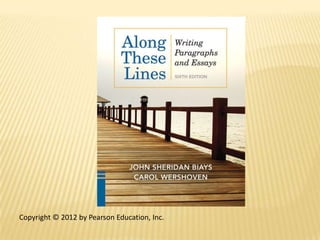
Chapter 4
- 1. Copyright © 2012 by Pearson Education, Inc.
- 2. CHAPTER 4: NARRATION Copyright © 2012 by Pearson Education, Inc.
- 3. CHAPTER OUTLINE AND LEARNING OBJECTIVES In this chapter, you will learn to write a narrative paragraph that: has a narrow focus, presents details in a clear order, and uses effective transitional words. Copyright © 2012 by Pearson Education, Inc.
- 4. WHAT IS NARRATION? Narration means telling a story. When you write a narrative paragraph, you can tell a story about something that happened to you or to someone else, or about something that you saw or read. A narrative relies on specific details about happenings: events, actions, incidents. Use vivid details so you don’t just tell the story, you show it. Copyright © 2012 by Pearson Education, Inc.
- 5. WHAT IS NARRATION? Give the Narrative a Point The point will be included in the topic sentence. The point of a narrative is the meaning of the incident or incidents that you are writing about. Hints for Writing a Narrative Paragraph 1. Be clear. 2. Be interesting. 3. Stay in order. 4. Pick a topic that is not too big. Use a Speaker’s Exact Words in Narrative Be sure to punctuate speech correctly. Copyright © 2012 by Pearson Education, Inc.
- 6. WRITING THE NARRATIVE PARAGRAPH IN STEPS PrewritingNarration—how to generate and develop ideas for your narration paragraph Planning Narration—how to organize your ideas for your narration paragraph Drafting and Revising Narration—how to create, revise, and edit rough drafts of your narration paragraph Proofreading Narration—how to proofread and make one final check of your narration paragraph Copyright © 2012 by Pearson Education, Inc.
- 7. PREWRITING NARRATION Thinking of a topic for a narrative paragraph can be a challenge. Narrative Questionnaire Freewriting for a Narrative Topic Narrowing and Selecting a Suitable Narrative Topic After freewriting, assess your writing, looking for words, phrases, or sentences that could be expanded into a paragraph. Questions can help you form the point of your narrative. Copyright © 2012 by Pearson Education, Inc.
- 8. PLANNING NARRATION Begin with a rough outline with the point as the topic sentence. Check the outline for the following: Relevance: Do all the details connect to the topic sentence? Order: Are the details in a clear order? Development: Does the outline need more details? Are the details specific enough? Outline for a Narrative Paragraph Copyright © 2012 by Pearson Education, Inc.
- 9. DRAFTING AND REVISING NARRATION After you have an outline, the next step is to create a rough draft. Checklist for Revising the Draft of a Narrative Paragraph Revising for Sharper Details Checking the Topic Sentence Rewrite the topic sentence to fit all the details. Copyright © 2012 by Pearson Education, Inc.
- 10. DRAFTING AND REVISING NARRATION Using Transitions Effectively in Narration Most of the transitions in narration have to do with time. A Revised Draft Once the time order is correct, a writer has to focus on two issues: 1. Making sure the narrative is more than a list of details in time sequence, and 2. Avoiding short, choppy writing. Copyright © 2012 by Pearson Education, Inc.
- 11. DRAFTING AND REVISING NARRATION A good revision may include: using transitions, combining sentences, and using exact words of dialogue. INFO BOX: Transitions for a Narrative Paragraph Copyright © 2012 by Pearson Education, Inc.
- 12. PROOFREADINGNARRATION Look for errors in spelling, punctuation, or preparation of the paragraph. Lines of Detail: A Walk-Through Assignment Topics for Writing a Narrative Paragraph Topics for Critical Thinking and Writing Copyright © 2012 by Pearson Education, Inc.
- 13. WHAT IS NARRATION? A. Explains how to do something. B. Tells a story. C. Shows a reader what a person, place, thing, or situation is like. D. Discusses differences. Copyright © 2012 by Pearson Education, Inc.
- 14. WHAT IS NARRATION? A. Explains how to do something. B. Tells a story. C. Shows a reader what a person, place, thing, or situation is like. D. Discusses differences. has a narrow focus Copyright © 2012 by Pearson Education, Inc.
- 15. WHICH OF THE FOLLOWING IS NOT A HINT FOR WRITING A NARRATIVE? A. Be clear. B. Be interesting. C. Stay in order. D. Include steps. Copyright © 2012 by Pearson Education, Inc.
- 16. WHICH OF THE FOLLOWING IS NOT A HINT FOR WRITING A NARRATIVE? A. Be clear. B. Be interesting. C. Stay in order. D. Include steps. presents details in a clear order Copyright © 2012 by Pearson Education, Inc.
- 17. WHICH OF THE FOLLOWING IS A COMMON TRANSITION FOR A NARRATIVE PARAGRAPH? A. Suddenly B. Nevertheless C. Similarly D. For example Copyright © 2012 by Pearson Education, Inc.
- 18. WHICH OF THE FOLLOWING IS A COMMON TRANSITION FOR A NARRATIVE PARAGRAPH? A. Suddenly B. Nevertheless C. Similarly D. For example uses effective transitional words. Copyright © 2012 by Pearson Education, Inc.
Notas del editor
- Review objectives.
- Explainnarration Engage in a discussion about narratives
- Review narration and the hints for writing a narrative paragraph. Share examples of narrative paragraphs.
- Review the stages of the writing process for writing the narrative paragraph.
- Introduce the narrative questionnaire. In groups, have students complete a narrative questionnaire. Direct students to freewrite about something that changed their lives. After the freewriting, have students select a topic from the list of details.
- Havestudents create an outline from the list of details created during the freewrite.
- Have students create a rough draft of their narrative paragraph. In partner groups, have students peer review drafts. Direct students to use the revision checklist.
- Review transitions
- Direct students to proofread paragraphs Have students